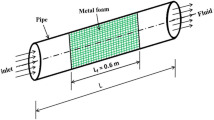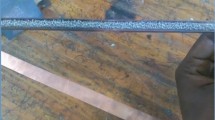Abstract
This paper presents an investigation of the boiling heat transfer of R141b in a mini-channel with a 2.42-mm inner diameter filled with metal foam. Investigations are performed at velocity of 0.01 m s−1 and temperature of 450 K. The coupled level set and volume-of-fluid method is applied to simulate flow boiling in metal foam. It considers that the bubble number and the average bubble area have influence on the heat transfer coefficient. The simulation model is verified by experimental data with an emphasis on the effect of boiling bubbles and turbulent kinetic energy on heat transfer. The simulation results show that even though the bubble motion range and vortices area is smaller, more vortices appear in the channel filled with foam metal, which increase the mixing frequency and improve the heat transfer performance. Meanwhile, the heat transfer coefficient is inversely proportional to the average bubble area but proportional to the bubble number. The relationship between turbulent kinetic energy and heat transfer coefficient is also compared. Results indicate that the differentiation of turbulent kinetic energy to time appears consistent with the heat transfer coefficient in the mini-channel filled with metal foam.



















Similar content being viewed by others
Abbreviations
- C p :
-
Specific heat capacity (J kg−1 K−1)
- D :
-
Sphere diameter (m)
- d :
-
Shortest distance to the interface (m)
- E :
-
VOF model treats energy
- F :
-
Volume force (N)
- F st :
-
Surface tension force (N)
- F sl :
-
Shear lift force (N)
- F du :
-
Unsteady drag force (N)
- F qsd :
-
Quasi-steady drag force (N)
- F p :
-
Hydraulic pressure force (N)
- F cp :
-
Contact pressure force (N)
- F b :
-
Buoyancy force (N)
- F r :
-
Resistance force (N)
- F f :
-
Friction force (N)
- h :
-
Grid spacing
- h c :
-
Convective heat transfer coefficient (W m−2 K−1)
- h fg :
-
Latent heat of evaporation (kJ kg−1)
- K :
-
Turbulent kinetic energy (J kg−1)
- k eff :
-
Effective thermal conductivity (W m−1 K−1)
- k :
-
Curvature
- L :
-
Tetradecahedron length (m)
- l :
-
Characteristic length (m)
- m :
-
Mass source term
- ṁ :
-
Mass transfer
- N :
-
Number of bubbles
- Nu:
-
Nusselt number \( {\text{Nu}} = \frac{{h_{\text{c}} l}}{{k_{\text{eff}} }} \)
- n :
-
Normal vector
- PPI:
-
Pores per inch
- S :
-
Source term
- T :
-
Temperature (K)
- u :
-
Underlying velocity field
- Pr:
-
Turbulent Prandtl number \( { \Pr } = \frac{{\mu C_{\text{p}} }}{{k_{\text{eff}} }} \)
- α :
-
Volume fraction
- ρ :
-
Density (kg m−3)
- σ :
-
Surface tension (N m−1)
- μ :
-
Viscosity (Pa s)
- ave:
-
Average
- Ɩ:
-
Liquid
- v:
-
Vapor
References
Kandlikar SG, Grande WJ. Evolution of microchannel flow passages—thermohydraulic performance and fabrication technology. Heat Transf Eng. 2003;24(1):3–17.
Zhu Y, Hu H, Sun S, Ding G. Flow boiling of refrigerant in horizontal metal-foam filled tubes: part 1—two-phase flow pattern visualization. Int J Heat Mass Transf. 2015;91:446–53.
Zhu Y, Hu H, Sun S, Ding G. Flow boiling of refrigerant in horizontal metal-foam filled tubes: part 2—a flow-pattern based prediction method for heat transfer. Int J Heat Mass Transf. 2015;91:502–11.
Abadi GB, Moon C, Kim KC. Flow boiling visualization and heat transfer in metal-foam-filled mini tubes—part I: flow pattern map and experimental data. Int J Heat Mass Transf. 2016;98:857–67.
Abadi GB, Moon C, Kim KC. Flow boiling visualization and heat transfer in metal-foam-filled mini tubes—part II: developing predictive methods for heat transfer coefficient and pressure drop. Int J Heat Mass Transf. 2016;98:868–78.
Diani A, Mancin S, Doretti L, Rossetto L. Low-GWP refrigerants flow boiling heat transfer in a 5 PPI copper foam. Int J Multiph Flow. 2015;76:111–21.
Mancin S, Diani A, Doretti L, Rossetto L. R134a and R1234ze(E) liquid and flow boiling heat transfer in a high porosity copper foam. Int J Heat Mass Transf. 2014;74:77–87.
Gao W, Xu X, Liang X. Flow boiling of R134a in an open-cell metal foam mini-channel evaporator. Int J Heat Mass Transf. 2018;126:103–15.
Xu HJ, Qu ZG, Tao WQ. Thermal transport analysis in parallel-plate channel filled with open-celled metallic foams. Int Commun Heat Mass Transf. 2011;38:868–73.
Rehman T, Ali HM, Janjua MM, Sajjad U, Yan WM. A critical review on heat transfer augmentation of phase change materials embedded with porous materials/foams. Int J Heat Mass Transf. 2019;135:649–73.
Rehman T, Ali HM, Saieed A, Pao W, Ali M. Copper foam/PCMs based heat sinks: an experimental study for electronic cooling systems. Int J Heat Mass Transf. 2018;127:381–93.
Rehman T, Ali HM. Experimental investigation on paraffin wax integrated with copper foam based heat sinks for electronic components thermal cooling. Int Commun Heat Mass Transf. 2018;98:155–62.
Qureshi ZA, Ali HM, Khushnood S. Recent advances on thermal conductivity enhancement of phase change materials for energy storage system: a review. Int J Heat Mass Transf. 2018;127:838–56.
Liu Q, Palm B. Numerical study of bubbles rising and merging during convective boiling in micro-channels. Appl Therm Eng. 2016;99:1141–51.
Liu Q, Wang W, Palm B. A numerical study of the transition from slug to annular flow in micro-channel convective boiling. Appl Therm Eng. 2017;112:73–81.
Ling K, Son G, Sun DL, Tao WQ. Three dimensional numerical simulation on bubble growth and merger in microchannel boiling flow. Int J Therm Sci. 2015;98:135–47.
Katiyar G, Karagadde S, Saha SK, Sharma A. Numerical modelling of bubble growth in microchannel using level set method. Int J Heat Mass Transf. 2016;101:719–32.
Du J, Zhao C, Bo H. A modified model for bubble growth rate and bubble departure diameter in nucleate pool boiling covering a wide range of pressures. Appl Therm Eng. 2018;145:407–15.
Mazzocco T, Ambrosini W, Kommajosyula R, Baglietto E. A reassessed model for mechanistic prediction of bubble departure and lift off diameters. Int J Heat Mass Transf. 2018;117:119–24.
Raj S, Pathak M, Khan MK. An analytical model for predicting growth rate and departure diameter of a bubble in subcooled flow boiling. Int J Heat Mass Transf. 2017;109:470–81.
Colombo M, Fairweather M. Prediction of bubble departure in forced convection boiling: a mechanistic model. Int J Heat Mass Transf. 2015;85:135–46.
Setoodeh H, Ding W, Lucas D, Hampel U. Prediction of bubble departure in forced convection boiling with a mechanistic model that considers dynamic contact angle and base expansion. Energies. 2019;12:1950.
Abdous MA, Holagh SG, Shamsaiee M, Saffari H. The prediction of bubble departure and lift-off radii in vertical U-shaped channel under subcooled flow boiling based on forces balance analysis. Int J Therm Sci. 2019;142:316–31.
Esmaeilzadeh A, Amanifard N, Deylami HM. Comparison of simple and curved trapezoidal longitudinal vortex generators for optimum flow characteristics and heat transfer augmentation in a heat exchanger. Appl Therm Eng. 2017;125:1414–25.
Ke Z, Chen CL, Li K, Wang S, Chen CH. Vortex dynamics and heat transfer of longitudinal vortex generators in a rectangular channel. Int J Heat Mass Transf. 2019;132:871–85.
Kashyap U, Das K, Debnath BK. Effect of surface modification of a rectangular vortex generator on heat transfer rate from a surface to fluid: an extended study. Int J Therm Sci. 2018;134:269–81.
Liu Y, Ma X, Ye X, Chen Y, Cheng Y, Lan Z. Heat transfer enhancement of annular finned tube exchanger using vortex generators: the effect of oriented functional circumferential arrangement. Therm Sci Eng Prog. 2019;10:27–35.
Lee WH. A pressure iteration scheme for two-phase flow modeling. 1980.
Fluent. ANSYS fluent 15.0 theory guide. Canonsburg: Fluent Inc; 2013.
Bai M, Chung JN. Analytical and numerical prediction of heat transfer and pressure drop in open-cell metal foams. Int J Therm Sci. 2011;50:869–80.
Feng S, Shi M, Li Y, Lu TJ. Pore-scale and volume-averaged numerical simulations of melting phase change heat transfer in finned metal foam. Int J Heat Mass Transf. 2015;90:838–47.
Moffat RJ. Describing the uncertainties in experimental results. Exp Therm Fluid Sci. 1988;1(1):3–17.
Acknowledgements
The financial support of the National Nature Science Foundation of China (Nos. 51406031, 51776033) and the Science Foundation of the Jilin province (Grant 20170101123JC) are gratefully acknowledged.
Author information
Authors and Affiliations
Corresponding author
Additional information
Publisher's Note
Springer Nature remains neutral with regard to jurisdictional claims in published maps and institutional affiliations.
Rights and permissions
About this article
Cite this article
Li, HW., Li, HY., Zheng, LT. et al. Research on the effect of bubble dynamics and turbulent kinetic energy on heat transfer in mini-channels filled with metal foam. J Therm Anal Calorim 141, 69–81 (2020). https://doi.org/10.1007/s10973-019-08919-w
Received:
Accepted:
Published:
Issue Date:
DOI: https://doi.org/10.1007/s10973-019-08919-w




